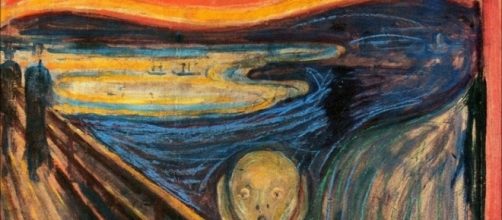Meteorologists out of Norway have announced a discovery about “The Scream,” the popular painting of a man awed by a raging red sunset and squally clouds. The image is commonly understood as an expression of the artist’s frenzied state of mind conditioned by an unhappy life that began in childhood. That’s not how the scientists see it. “We argue that the Norwegian painter Edvard Munch may have been terrified after seeing a spectacular “mother-of-pearl” cloud event and that experience was what prompted him to paint ‘The Scream.” This news is odd because the artist already said as much in a diary entry dated 1892.
While out for a walk as the sun was setting he saw the clouds suddenly turn “blood red.” The color was so loud that he “sensed an infinite scream passing through nature.” The scientists’ so-called discovery is 125 years old.
Stormy weather
Even more odd, the meteorologists cite the very diary entry that Munch penned as the source of their disclosure, as if no one had read it until they did. But even without that reference, anyone can tell what Munch had in mind when he made the painting by the actual title he gave it: “The Scream of Nature.” And a close look at the painting also tells the story. It’s not the man in the picture who is screaming, it’s Mother Nature doing it with colors so shrill that the man is holding his ears.
Yet there was Dr. Helene Muri from the University of Oslo last month telling the European Geo sciences Union General Assembly in Vienna that Munch was taken by “nacreous clouds” (screaming clouds), which she said form at sunset in a very cold climate. If there was any screaming going on, it came from nature, not Munch. Where have you been, Dr.
Muri?
Reasons why
And here’s another question. Given all the devastation from global warming and all the life-threatening weather conditions affecting land and sea, man and beast, shouldn’t meteorologists be concentrating on current events rather than on a 19th century painting? I’m reminded of another scientist also in need of an art history lesson.
Japanese medical scientist, Kazunoro Asada proclaimed in 2012 that the raw colors in Van Gogh’s “Night Café” indicated color blindness. Like Dr. Muri, Dr. Asada didn’t do his homework. He didn’t read what the Dutch painter wrote about why he chose such a vivid palette for “Night Café”: “I have tried to express with red and green the terrible passion of human nature.”
Scientists have also argued that Van Gogh’s big use of yellow and wavy lines were the result of glaucoma. Never mind the artist’s own words about how Rubens’ energetic brushwork, vivid palette and sinuous and twisting lines influenced the way he painted. If scientists want to play at art history, they ought to read some.


